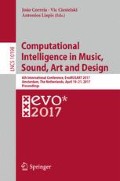Abstract
It has been demonstrated that computational evolution can be utilised in the creation of aesthetic analogies between two artistic domains by the use of mapping expressions. When given an artistic input these mapping expressions can be used to guide the generation of content in a separate domain. For example, a piece of music can be used to create an analogous visual display. In this paper we examine the implementation and performance of such a system. We explore the practical implementation of real-time evaluation of evolved mapping expressions, possible musical input and visual output approaches, and the challenges faced therein. We also present the results of an exploratory study testing the hypothesis that an evolved mapping expression between the measurable attributes of musical and visual harmony will produce an improved aesthetic experience compared to a random mapping expression. Expressions of various fitness values were used and the participants were surveyed on their enjoyment, interest, and fatigue. The results of this study indicate that further work is necessary to produce a strong aesthetic response. Finally, we present possible approaches to improve the performance and artistic merit of the system.
Access this chapter
Tax calculation will be finalised at checkout
Purchases are for personal use only
Notes
- 1.
Full results are available upon request. Please contact a.breen2@nuigalway.ie.
References
Becker, J.D.: The modeling of simple analogic and inductive processes in a semantic memory system. In: Proceedings of IJCAI-1969, pp. 655–668, Washington (1969). http://citeseerx.ist.psu.edu/viewdoc/download?doi=10.1.1.77.8346&rep=rep.1&type=pdf
Behravan, R.: Automatic mapping of emotion in music to abstract visual arts. Ph.D. thesis, University College London (2007)
Birkhoff, G.: Aesthetic Measure. Cambridge University Press, Cambridge (1933)
Eliasmith, C., Thagard, P.: Integrating structure and meaning: a distributed model of analogical mapping. Cogn. Sci. 25(2), 245–286 (2001)
Evans, T.G.: A program for the solution of a class of geometric-analogy intelligence-test questions. Technical report, Air Force Cambridge Research Labs LG Hanscom Field (1964)
French, R.M.: The computational modeling of analogy-making. Trends Cogn. Sci. 6(5), 200–205 (2002). http://www.ncbi.nlm.nih.gov/pubmed/11983582
Gentner, D.: Children’s performance on a spatial analogies task. Child Dev. 48, 1034–1039 (1977)
Gentner, D., Forbus, K.D.: Computational models of analogy. Wiley Interdisc. Rev. Cogn. Sci. 2(3), 266–276 (2011). http://doi.wiley.com/10.1002/wcs.105
Goguen, J.A.: Art and the brain: editorial introduction. J. Conscious. Stud. 6(6), 5–14 (1999)
Hofstadter, D.R.: Analogy as the core of cognition. In: Gentner, D., Holyoak, K., Kokinov, B. (eds.) The Analogical Mind: Perspectives from Cognitive Science, pp. 499–538. MIT Press, Cambridge (2001)
Huang, M.: The neuroscience of art. Stanford J. Neurosci. 2(1), 24–26 (2009). http://www.stanford.edu/group/co-sign/huang.pdf
Hummel, J.E., Holyoak, K.J.: Distributed representations of structure: a theory of analogical access and mapping. Psychol. Rev. 104(3), 427 (1997)
IBM Corp: IBM SPSS Statistics for Windows (2013)
Kandinsky, W., Rebay, H.: Point and Line to Plane. Courier Corporation, North Chelmsford (1947)
Klee, P.: Pedagogical Sketchbook. Praeger Publishers, New York (1925). http://monoskop.org/images/3/30/Klee_Paul_Pedagogical_Sketchbook_1960.pdf
Marshall, J.B., Hofstadter, D.R.: The metacat project: a self-watching model of analogy-making. Cogn. Stud. Bull. Japn. Cogn. Sci. Soc. 4(4), 57–71 (1997)
Mitchell, M.: Analogy-Making as Perception: A Computer Model. MIT Press, Cambridge (1993)
O’Neil, M., Ryan, C.: Grammatical Evolution, pp. 33–47. Springer, Heidelberg (2003)
Palmer, S.E., Schloss, K.B., Sammartino, J.: Visual aesthetics and human preference. Ann. Rev. Psychol. 64, 77–107 (2013)
Ramachandran, V.S., Hirstein, W.: The science of art: a neurological theory of aesthetic experience. J. Conscious. Stud. 6(6), 15–35 (1999)
Reitman, W.R.: Cognition and Thought: An Information Processing Approach. Wiley, New York (1965)
Thibaut, J.P., French, R., Vezneva, M.: The development of analogy making in children: cognitive load and executive functions. J. Exp. Child Psychol. 106(1), 1–19 (2010)
Author information
Authors and Affiliations
Corresponding author
Editor information
Editors and Affiliations
Rights and permissions
Copyright information
© 2017 Springer International Publishing AG
About this paper
Cite this paper
Breen, A., O’Riordan, C., Sheahan, J. (2017). Evolved Aesthetic Analogies to Improve Artistic Experience. In: Correia, J., Ciesielski, V., Liapis, A. (eds) Computational Intelligence in Music, Sound, Art and Design. EvoMUSART 2017. Lecture Notes in Computer Science(), vol 10198. Springer, Cham. https://doi.org/10.1007/978-3-319-55750-2_5
Download citation
DOI: https://doi.org/10.1007/978-3-319-55750-2_5
Published:
Publisher Name: Springer, Cham
Print ISBN: 978-3-319-55749-6
Online ISBN: 978-3-319-55750-2
eBook Packages: Computer ScienceComputer Science (R0)

